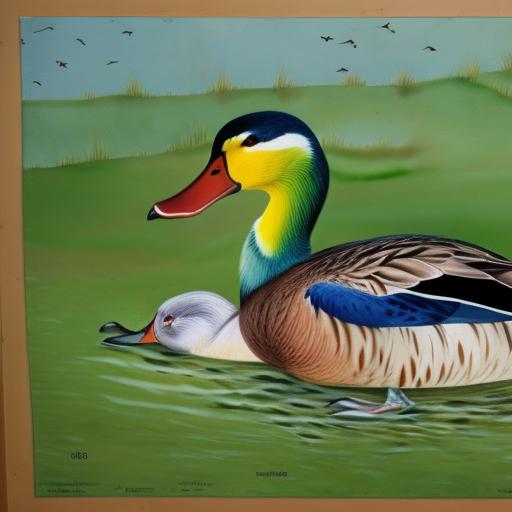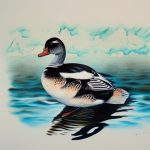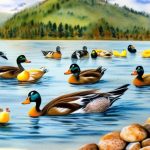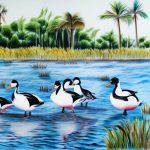Wild duck breeds are a diverse group of waterfowl that are found in various habitats around the world. These birds are known for their beautiful plumage, unique behaviors, and important ecological roles. Wild ducks are a crucial part of many ecosystems, as they help control insect populations, disperse seeds, and provide food for predators. There are many different species of wild ducks, each with its own unique characteristics and adaptations that allow them to thrive in their specific environments. From the colorful and vocal mallard to the elusive and migratory northern pintail, wild duck breeds are a fascinating and important part of the natural world.
Key Takeaways
- Wild duck breeds are diverse and have unique characteristics that make them interesting to study and conserve.
- Different wild duck breeds have distinct physical and behavioral traits that set them apart from each other.
- Some popular wild duck breeds include the Mallard, Wood Duck, and Northern Pintail, each with its own unique features and habitat preferences.
- Wild duck breeds can be found in a variety of habitats across the world, from wetlands and marshes to rivers and lakes.
- Conservation efforts are important for preserving the genetic diversity and natural habitats of wild duck breeds, which are often threatened by habitat loss and hunting pressures.
Characteristics of Different Wild Duck Breeds
Wild duck breeds come in a wide variety of shapes, sizes, and colors. One of the most well-known and widespread wild duck breeds is the mallard, which is easily recognizable by its iridescent green head, bright yellow bill, and mottled brown body. Mallards are known for their adaptability and can be found in a wide range of habitats, from urban ponds to remote marshes. Another popular wild duck breed is the northern pintail, which is known for its long, elegant neck and distinctive pointed tail feathers. Pintails are migratory birds and can be found in North America, Europe, and Asia. Other wild duck breeds include the wood duck, with its stunning iridescent plumage, the colorful teal, and the strikingly patterned shoveler. Each wild duck breed has its own unique characteristics and behaviors that make them fascinating to observe and study.
Popular Wild Duck Breeds
There are several popular wild duck breeds that are well-known among birdwatchers and wildlife enthusiasts. One of the most iconic wild duck breeds is the mallard, which is found throughout North America, Europe, and Asia. Mallards are known for their distinctive green head, yellow bill, and mottled brown body. They are also famous for their loud quacking calls and their adaptability to a wide range of habitats. Another popular wild duck breed is the northern pintail, which is known for its elegant appearance and long, pointed tail feathers. Pintails are migratory birds that can be found in wetlands and marshes across North America, Europe, and Asia. Other popular wild duck breeds include the wood duck, with its stunning iridescent plumage, the colorful teal, and the strikingly patterned shoveler. These wild duck breeds are beloved by birdwatchers for their beauty and unique behaviors.
Habitat and Distribution of Wild Duck Breeds
Wild duck breeds can be found in a wide variety of habitats around the world, from freshwater marshes and rivers to coastal estuaries and open ocean. Different species of wild ducks have adapted to thrive in specific environments, such as the wood duck’s preference for wooded swamps and the northern pintail’s reliance on open wetlands. Mallards are highly adaptable and can be found in almost any wetland habitat, from urban ponds to remote marshes. Teals prefer shallow freshwater habitats with plenty of vegetation for cover, while shovelers are often found in open wetlands with abundant food sources. The distribution of wild duck breeds varies depending on the species, with some being widespread across multiple continents, while others have more restricted ranges. Understanding the habitat preferences and distribution of wild duck breeds is crucial for their conservation and management.
Conservation of Wild Duck Breeds
Conservation efforts for wild duck breeds are crucial to ensure the survival of these important waterfowl species. Habitat loss, pollution, hunting pressure, and climate change are all significant threats to wild duck populations around the world. Many organizations and government agencies work to protect and restore wetland habitats that are crucial for wild ducks’ survival. Conservation efforts also include regulating hunting seasons and bag limits to ensure sustainable harvests of wild ducks. Additionally, captive breeding programs have been established to bolster populations of threatened wild duck breeds. These programs aim to release captive-bred ducks into the wild to supplement natural populations and increase genetic diversity. Public education and outreach programs also play a vital role in raising awareness about the importance of conserving wild duck breeds and their habitats.
Breeding and Reproduction of Wild Duck Breeds
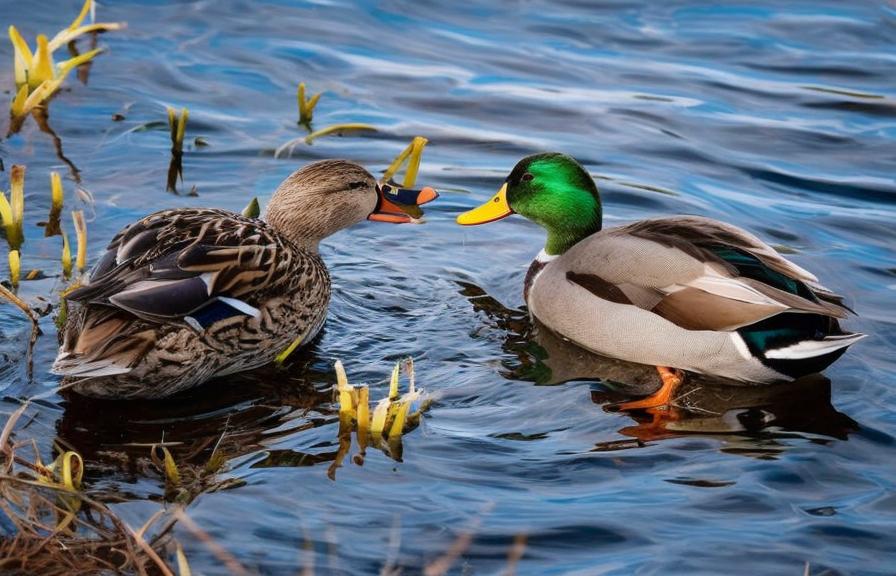
Wild duck breeds have fascinating breeding behaviors and reproductive strategies that vary among different species. Most wild ducks are monogamous during the breeding season, forming pairs that stay together to raise their offspring. Male ducks often display elaborate courtship behaviors to attract females, including vocalizations, head bobbing, and wing flapping. Once a pair has formed, the female selects a nesting site in dense vegetation near water, where she lays a clutch of eggs. After an incubation period of several weeks, the eggs hatch, and the female leads her ducklings to water where they can feed and grow. Some species of wild ducks are precocial, meaning that their young are able to feed themselves shortly after hatching, while others are altricial and require more care from their parents. Understanding the breeding and reproductive behaviors of wild duck breeds is essential for their conservation and management.
Interactions with Humans: Hunting and Domestication of Wild Duck Breeds
Wild duck breeds have long been important to humans for food, sport, and domestication. Ducks have been hunted for thousands of years for their meat, eggs, and feathers. In many cultures, hunting wild ducks is a popular recreational activity that provides food for families and communities. However, overhunting can have negative impacts on wild duck populations if not managed sustainably. Domestication of wild ducks has also played a significant role in human history, with many domestic duck breeds being derived from wild ancestors. Domestic ducks are raised for meat, eggs, feathers, and pest control in agricultural settings around the world. Understanding the interactions between humans and wild duck breeds is crucial for ensuring sustainable management practices that benefit both people and wildlife.
If you’re interested in learning more about wild duck breeds, you might also want to check out this insightful article on Poultry Wizard about the importance of the right chicken coop door size here. Understanding the specific needs and behaviors of different poultry breeds, including ducks and geese, can help ensure their well-being and productivity.
FAQs
What are some common wild duck breeds?
Some common wild duck breeds include the Mallard, Wood Duck, Northern Pintail, Gadwall, and American Wigeon.
Where can wild duck breeds be found?
Wild duck breeds can be found in a variety of habitats including wetlands, marshes, lakes, rivers, and coastal areas. They are also commonly found in agricultural areas and urban parks.
What do wild duck breeds eat?
Wild duck breeds are omnivorous and their diet consists of a variety of foods including aquatic plants, insects, small fish, and crustaceans.
How do wild duck breeds differ from domestic duck breeds?
Wild duck breeds are typically more colorful and have more varied plumage compared to domestic duck breeds. They also have a more streamlined and agile build, suited for their natural habitat.
Are wild duck breeds protected by law?
In many countries, wild duck breeds are protected by law to ensure their conservation and sustainable management. It is important to check local regulations before hunting or interacting with wild duck breeds.
Meet Walter, the feathered-friend fanatic of Florida! Nestled in the sunshine state, Walter struts through life with his feathered companions, clucking his way to happiness. With a coop that’s fancier than a five-star hotel, he’s the Don Juan of the chicken world. When he’s not teaching his hens to do the cha-cha, you’ll find him in a heated debate with his prized rooster, Sir Clucks-a-Lot. Walter’s poultry passion is no yolk; he’s the sunny-side-up guy you never knew you needed in your flock of friends!

